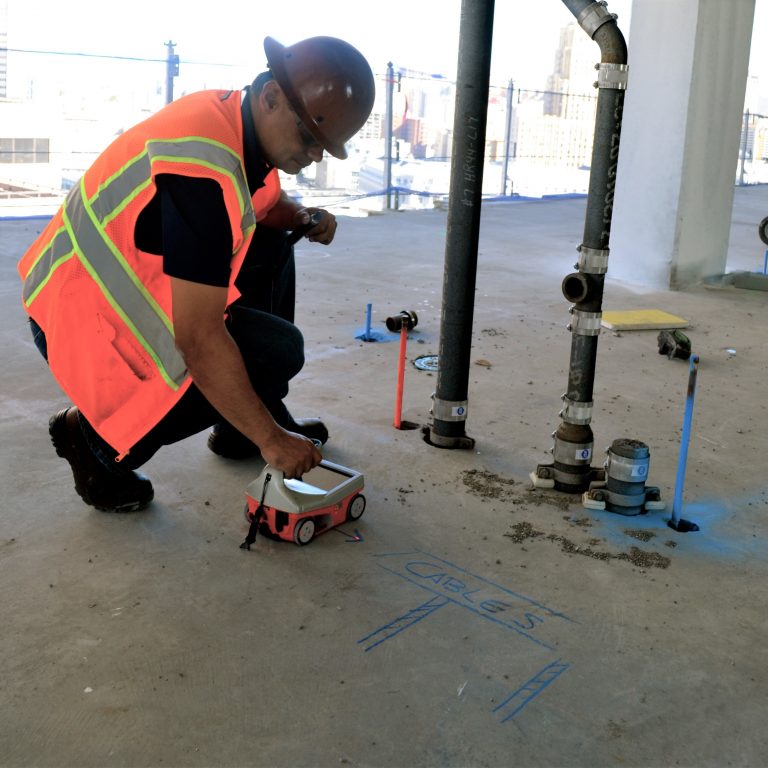Unveil the Transformative Power of Concrete Scanning in Making The Most Of Efficiency and Safety
Concrete scanning has actually arised as an essential tool in the building market, using unequaled benefits in boosting task performance and making sure security standards. The transformative power of concrete scanning lies in its capability to supply detailed understandings and real-time data, changing just how jobs are intended and carried out.
Importance of Concrete Scanning
Ensuring the architectural stability and security of construction jobs begins with the crucial step of carrying out comprehensive concrete scanning. Concrete scanning is a non-destructive method used to spot and map subsurface aspects within concrete frameworks. This process is essential in recognizing potential hazards, such as rebar, post-tension cable televisions, and conduits, that might be hidden within the concrete. By utilizing sophisticated modern technologies like ground-penetrating radar (GPR) and electro-magnetic induction, construction teams can properly situate these components without causing any kind of damages to the structure.
In addition, concrete scanning aids in maximizing task timelines and spending plan by preventing unexpected expenses and delays that may occur due to unpredicted blockages within the concrete. Inevitably, spending in comprehensive concrete scanning is a proactive technique that boosts both performance and safety in building projects.
Just How Concrete Scanning Works
Concrete scanning runs as a critical device in construction projects by utilizing innovative modern technologies to discover and map subsurface components without creating architectural damage. Ground Permeating Radar (GPR) and Electromagnetic Induction (EMI) are two primary techniques used in concrete scanning.
During the scanning procedure, the data collected is analyzed in real-time, allowing prompt recognition of potential risks or barriers underneath the surface area. This details help in decision-making, ensuring that building activities proceed securely and effectively. Furthermore, 3D imaging software application can be made use of to develop topographic maps of the subsurface elements, even more enhancing task planning and implementation. By using these innovative innovations, concrete scanning substantially lowers the danger of costly damages and injuries on building websites.
Benefits of Concrete Scanning
Utilizing sophisticated scanning technologies in building jobs supplies a multitude of benefits, boosting both effectiveness and safety and security on-site. One of the key advantages of concrete scanning is the ability to discover and locate embedded things such as rebar, post-tension cords, and channels properly. By determining these elements prior to exploration or reducing right into concrete structures, the danger of unexpected strikes is substantially lowered, preventing possible injuries to workers and damage to the structure itself. In addition, concrete scanning aids in preparation and developing better, as it offers specific information about the place and depth of structural components.

Study: Concrete Scanning Success

In an additional case, a building company used 3D concrete scanning to evaluate the condition of aging concrete structures in a historical building. The detailed scans given valuable insights into the degree of damage and aided prioritize upkeep initiatives successfully. By proactively attending to locations of problem recognized via scanning, the business was able to expand the life expectancy of the framework and ensure occupant safety and security.
These instance studies highlight the transformative power of concrete scanning in boosting efficiency, precision, and security in construction tasks.
Applying Concrete Scanning in Projects
Executing innovative scanning modern technologies during building tasks has become progressively crucial for enhancing accuracy and safety and security. By incorporating concrete scanning into task planning and implementation, building and construction teams can identify possible risks, such as rebar or post-tension cable televisions, hidden within concrete frameworks. This proactive strategy lessens the threat of mishaps, hold-ups, and costly rework, inevitably leading to a lot more reliable job timelines and budget plans.
To execute concrete scanning effectively, project supervisors ought to team up very closely with skilled scanning specialists to determine the most suitable scanning methods for the details project needs. Engaging scanning specialists from the early stages of a project allows the group to produce extensive scanning strategies that address vital areas of problem and make certain comprehensive information collection.
Additionally, including concrete scanning right into regular task process can enhance decision-making procedures, as real-time check information supplies immediate click this link insights into the condition of concrete structures - Concrete Scanning. This data-driven method assists in informed problem-solving and enables groups to make adjustments immediately, cultivating a culture of efficiency and security throughout the job lifecycle

Conclusion
To conclude, concrete scanning plays a critical duty in enhancing efficiency and security in building and construction jobs. By making use of sophisticated innovation to identify and map out underlying structures within concrete, this procedure assists to avoid expensive errors, make sure architectural honesty, and decrease dangers on site. With the capability to uncover hidden components and give accurate information, concrete scanning verifies to be a beneficial device for optimizing project results and taking full advantage of general success.
Concrete scanning is a non-destructive approach utilized to discover and map subsurface elements within concrete frameworks. Furthermore, concrete scanning helps in enhancing task timelines and budget plan by avoiding unanticipated costs and hold-ups that might develop due to unanticipated blockages within the concrete. One remarkable case research study entails a massive remodelling job where concrete scanning played an essential role in making certain project success.In another situation, a building and construction firm made use of 3D concrete scanning to analyze the problem of aging concrete structures in a historic structure. By incorporating concrete scanning right into Recommended Reading task preparation and implementation, building teams can determine possible risks, such as rebar or post-tension wires, concealed within concrete structures.